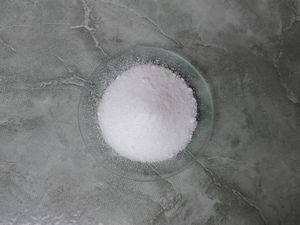Difference between revisions of "Sodium bromide"
From Sciencemadness Wiki
| (One intermediate revision by the same user not shown) | |||
| Line 7: | Line 7: | ||
| OtherNames = | | OtherNames = | ||
<!-- Images --> | <!-- Images --> | ||
| − | | ImageFile = | + | | ImageFile = Sodium bromide sample watchglass.jpg |
| − | | ImageSize = | + | | ImageSize = 300 |
| ImageAlt = | | ImageAlt = | ||
| ImageName = | | ImageName = | ||
| + | | ImageCaption = Sample of sodium bromide | ||
| ImageFile1 = | | ImageFile1 = | ||
| ImageSize1 = | | ImageSize1 = | ||
| Line 126: | Line 127: | ||
: 2 KBr + 2 HCl + H<sub>2</sub>O<sub>2</sub> → 2 KCl + Br<sub>2</sub> + 2 H<sub>2</sub>O | : 2 KBr + 2 HCl + H<sub>2</sub>O<sub>2</sub> → 2 KCl + Br<sub>2</sub> + 2 H<sub>2</sub>O | ||
| + | |||
| + | [[Potassium peroxymonosulfate|Oxone]] will also achieve the same result. | ||
===Physical=== | ===Physical=== | ||
| Line 140: | Line 143: | ||
: NaOH + HBr → NaBr + H<sub>2</sub>O | : NaOH + HBr → NaBr + H<sub>2</sub>O | ||
| − | Another route is to neutralize bromine with sodium thiosulfate or metabisulfite. | + | Another route is to neutralize [[bromine]] with [[sodium thiosulfate]] or metabisulfite. |
==Projects== | ==Projects== | ||
| Line 146: | Line 149: | ||
*Make hydrobromic acid | *Make hydrobromic acid | ||
*[[Finkelstein reaction]] | *[[Finkelstein reaction]] | ||
| + | *Make organobromine compounds | ||
==Handling== | ==Handling== | ||
| Line 171: | Line 175: | ||
[[Category:Neutral salts]] | [[Category:Neutral salts]] | ||
[[Category:Bromides]] | [[Category:Bromides]] | ||
| + | [[Category:Essential reagents]] | ||
Latest revision as of 15:16, 18 November 2023
 Sample of sodium bromide
| |
| Names | |
|---|---|
| IUPAC name
Sodium bromide
| |
| Preferred IUPAC name
Sodium bromide | |
| Properties | |
| NaBr | |
| Molar mass | 102.89 g/mol |
| Appearance | White solid |
| Odor | Odorless |
| Density | 3.21 g/cm3 (anhydrous) 2.18 g/cm3 (dihydrate) |
| Melting point | anhydrous 747 °C (1,377 °F; 1,020 K) dihydrate 36 °C (97 °F; 309 K) (decomposes) |
| Boiling point | 1,390 °C (2,530 °F; 1,660 K) |
| 71.35 g/100 ml (−20 °C) 79.52 g/100 ml (0 °C) 94.32 g/100 ml (25 °C) 104.9 g/100 ml (40 °C) 116.2 g/100 ml (100 °C) | |
| Solubility | Soluble in liq. ammonia, formic acid, hydrazine, pyridine, liq. SO2 Slightly soluble in ethanol Insoluble in acetone, acetonitrile |
| Solubility in dimethylformamide | 3.2 g/100 g (10.3 °C) |
| Solubility in ethanol | 2.45 g/100 g (0 °C) 2.32 g/100 g (20 °C) 2.29 g/100 g (30 °C) 2.35 g/100 g (70 °C) |
| Solubility in formic acid | 19.3 g/100 g (18 °C) 19.4 g/100 g (25 °C) |
| Solubility in glycerol | 38.7 g/100 g (20 °C) |
| Solubility in methanol | 17.3 g/100 g (0 °C) 16.8 g/100 g (20 °C) 16.1 g/100 g (40 °C) 15.3 g/100 g (60 °C) |
| Vapor pressure | ~0 mmHg |
| Acidity (pKa) | 7 |
| Thermochemistry | |
| Std molar
entropy (S |
86.82 J·mol-1·K-1 |
| Std enthalpy of
formation (ΔfH |
−361.41 kJ/mol |
| Hazards | |
| Safety data sheet | Sigma-Aldrich |
| Flash point | Non-flammable |
| Lethal dose or concentration (LD, LC): | |
| LD50 (Median dose)
|
3.500 mg/kg (rat, oral) |
| Related compounds | |
| Related compounds
|
Potassium bromide |
| Except where otherwise noted, data are given for materials in their standard state (at 25 °C [77 °F], 100 kPa). | |
| Infobox references | |
Sodium bromide is an inorganic compound with the formula NaBr.
Contents
Properties
Chemical
Sodium bromide will liberate free bromine if chlorine or an acid and oxidizer is used.
- 2 NaBr + Cl2 → 2 NaCl + Br2
- 2 KBr + 2 HCl + H2O2 → 2 KCl + Br2 + 2 H2O
Oxone will also achieve the same result.
Physical
Sodium bromide is a colorless white solid, soluble in water.
Availability
Sodium bromide is sold as brominating tablets at pool stores as an alternative to chlorine.
Can also be bought online or from lab suppliers.
Preparation
Can be prepared by neutralizing sodium hydroxide with hydrobromic acid.
- NaOH + HBr → NaBr + H2O
Another route is to neutralize bromine with sodium thiosulfate or metabisulfite.
Projects
- Make elemental bromine
- Make hydrobromic acid
- Finkelstein reaction
- Make organobromine compounds
Handling
Safety
NaBr has a very low toxicity with an oral LD50 estimated at 3.5 g/kg for rats.
Storage
Sodium bromide is best kept in closed bottles.
Disposal
Can be poured down the drain.